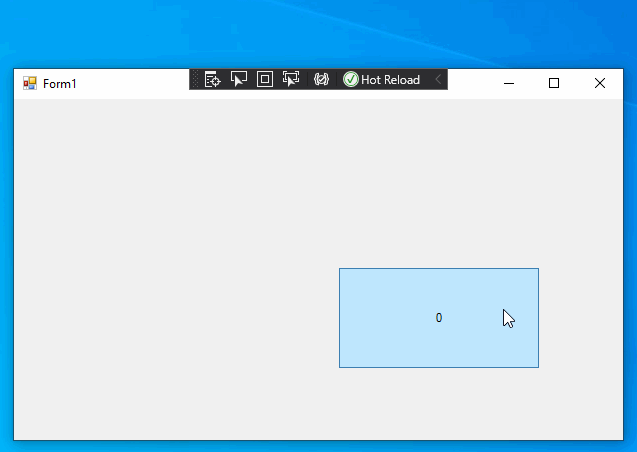HI
I wnat help please here is some of description :
Auto Clicker
Description:
I want the program to click while holding down the mouse button and I want it to stop clicking when you release the mouse button.
Visual description
problem:
I can not find anything that you can use to know when you press the mouse button. There are events for this inside the visual studio Forms but they only apply if the program is in focus.
using System;
using System.Collections.Generic;
using System.ComponentModel;
using System.Data;
using System.Drawing;
using System.Linq;
using System.Text;
using System.Threading.Tasks;
using System.Windows.Forms;
using System.Runtime.InteropServices;
using System.Windows.Input;
namespace autoClicker
{
public partial class Form1 : Form
{
[Flags]
private enum KeyStates
{
None = 0,
Down = 1,
Toggled = 2
}
[DllImport("user32.dll", CharSet = CharSet.Auto, CallingConvention = CallingConvention.StdCall)]
public static extern void mouse_event(uint dwFlags, uint dx, uint dy, uint cButtons, uint dwExtraInfo);
private const int MOUSEEVENTF_LEFTDOWN = 0x02;
private const int MOUSEEVENTF_LEFTUP = 0x04;
private const int MOUSEEVENTF_RIGHTDOWN = 0x08;
private const int MOUSEEVENTF_RIGHTUP = 0x10;
[DllImport("user32.dll", CharSet = CharSet.Auto, ExactSpelling = true)]
private static extern short GetKeyState(int keyCode);
int delay = 0;
int clicks = 0;
private Timer timer = new Timer();
private Timer timer2 = new Timer();
private Timer timer3 = new Timer();
private Timer timerCheck = new Timer();
public Form1()
{
InitializeComponent();
}
private void Form1_Load(object sender, EventArgs e)
{
RefreshDelay();
timer.Tick += new EventHandler(timer_Tick);
timerCheck.Tick += new EventHandler(TimerCheck_Tick);
timerCheck.Interval = 1;
}
int extraTime = 0;
private void TimerCheck_Tick(object sender, EventArgs e)
{
extraTime++;
if (timer.Enabled && extraTime > 5)
{
if (delay < 1) delay = 1;
timer.Interval = delay;
short retVal = GetKeyState((int)keyValue);
if ((retVal & 0x8000) == 0x8000)
{
timer.Enabled = false;
extraTime = 0;
}
}
else if(!timer.Enabled && extraTime > 5)
{
short retVal = GetKeyState((int)keyValue);
if ((retVal & 0x8000) == 0x8000)
{
timer.Enabled = true;
extraTime = 0;
}
}
}
private void start_Click(object sender, EventArgs e)
{
if (delay < 1) delay = 1;
timer.Interval = delay;
timer.Enabled = true;
}
private void stop_Click(object sender, EventArgs e)
{
timer.Enabled = false;
}
private void timer_Tick(object sender, EventArgs e)
{
DoClick();
}
private void DoClick()
{
//Call the imported function with the cursor's current position
uint x = Convert.ToUInt32(Cursor.Position.X);
uint y = Convert.ToUInt32(Cursor.Position.Y);
mouse_event(MOUSEEVENTF_LEFTDOWN | MOUSEEVENTF_LEFTUP, x, y, 0, 0);
}
#region Delay
int deleteMil = 0;
private void milliseconds_TextChanged(object sender, EventArgs e)
{
CreateDelay(milliseconds_T, ref deleteMil, 1);
}
int deleteSec = 0;
private void Seconds_T_TextChanged(object sender, EventArgs e)
{
CreateDelay(seconds_T, ref deleteSec, 1000);
}
int deleteMin = 0;
private void Minutes_T_TextChanged(object sender, EventArgs e)
{
CreateDelay(minutes_T, ref deleteMin, 60000);
}
private void CreateDelay(TextBox textBox, ref int deleteTime, int times)
{
string text = textBox.Text;
int addDelay;
int.TryParse(text, out addDelay);
try
{
delay -= deleteTime * times;
}
catch (Exception d) { }
delay += addDelay * times;
total.Text = delay.ToString();
deleteTime = addDelay;
}
private void RefreshDelay()
{
CreateDelay(milliseconds_T, ref deleteMil, 1);
CreateDelay(seconds_T, ref deleteSec, 1000);
CreateDelay(minutes_T, ref deleteMin, 60000);
}
#endregion
private void test_Click(object sender, EventArgs e)
{
clicks++;
test.Text = "Clicks " + clicks;
}
private void hotkey_Click(object sender, EventArgs e)
{
hotkey.Text = "Press a Key!";
KeyDown += new KeyEventHandler(Form1_KeyDown);
}
int keyValue;
private void Form1_KeyDown(object sender, KeyEventArgs e)
{
keyValue = e.KeyValue;
hotkey.Text = "Hotkey: " + e.KeyCode + " " + keyValue;
KeyDown -= new KeyEventHandler(Form1_KeyDown);
timerCheck.Start();
timerCheck.Interval = 1;
}
private bool checkMouse = false;
private void checkBox_CheckedChanged(object sender, EventArgs e)
{
checkMouse = checkBox.Checked;
}
}
}
using System;
using System.Windows.Forms;
namespace autoClicker
{
static class Program
{
[STAThread]
static void Main()
{
Application.EnableVisualStyles();
Application.SetCompatibleTextRenderingDefault(false);
Application.Run(new Form1());
}
}
}
Thak you for your help.
Regardes


